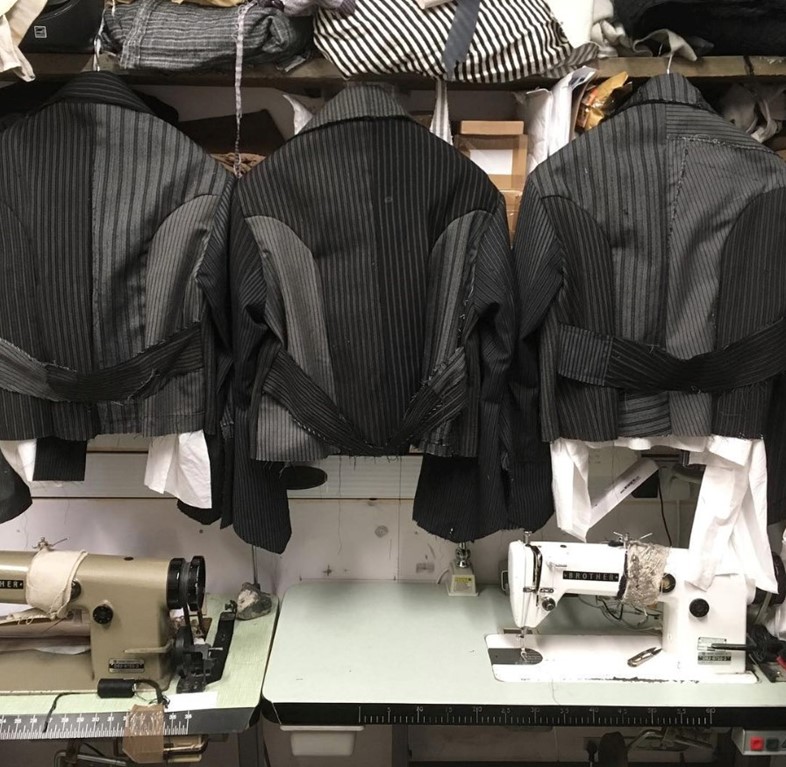A visual diary of sorts, John Skelton’s Instagram reveals his new breed of environmentalism – one that eschews the usual clichés
In support of 2018’s Fashion Revolution Week – an opportunity to reconsider the industry’s impact on the world, and the people living in it – anothermag.com is running a week-long series of stories about ethical fashion. Here, we encourage you to follow John Skelton, a British designer propositioning a new kind of sustainability.
Though John Skelton’s collections are informed by reams of thorough research – his most recent, held on Twelfth Night in St Mark’s Church in Dalston, emerged from a fascination with pre-industrial folk theatre and wassailing, a West Country tradition of singing to encourage harvest – they are just as likely to be traced back to a single piece of cloth.
His fascination with fabric, and the laborious processes he often uses to create those which form the basis of his collections (“I think I have a weird perverse thing about it, if I find something hard I want to do it more, even though I know it will be a nightmare,” he says over the phone) have made him one of the leaders a new breed of environmental fashion, propositioning a sustainability that eschews the usual clichés. Whether recycling old grain sacks, or dyeing antique fabrics with natural pigments like rust or leaves, he works with his hands, and the resources around him.
“It was always sustainable because it was naturally sustainable,” he says of how this particular fascination began. “It was really inherent in what I did, I found it all out in quite an organic way, it wasn’t conscious.” The recycling of old garments – many of which are from the Victorian era, and a hallmark of his work – was initially because he liked the way they looked, and felt. It means that working ethically is no afterthought, it is the very foundation of his design process.
That said, after working as a designer at a Swedish retailer before beginning his MA at Central Saint Martins, he realised that if he was ever to begin a personal brand, it would be the opposite of the large-scale production he encountered there. “I knew I wanted to do something that was the antithesis of that,” he says. “I wanted to do something sustainable.” The provenance of fabrics is important – he works with mills in the British Isles in a conscious effort to reduce his own carbon footprint.
But woven into these fabrics are tales, too – often, when he researches old methods of production he will learn of local myths or legends; those strange eccentricities of rural Britain. His work teems with suggestions of folklore, threaded through the garments with a single-handed approach. Sometimes, the confluence of fabric and storytelling will take him further afield – his S/S17 collection found inspiration in Gandhi’s khadi movement, which advocated hand-spinning as a form of protest against a damaging imperialist cotton trade with Britain.
Much of this storytelling is documented in fragments on his Instagram, where strange, disparate objects and swatches of fabric – one is decorated with the words old “Old Tosspot”; another shows a headpiece, made by Stephen Jones, formed from a Wicker Man-esque gathering of twigs – are enigmatically presented without explanation.
He admits, though, that he has a love-hate relationship with the medium. “Social media in general I’m not really the biggest fan of,” he laughs. “The good thing about it is that on the one side it’s really informative, I do learn a lot from it on a daily basis. But on the other side it’s a very dangerous thing, that can easily become quite vapid.”
He considers his own Instagram as a moodboard of sorts, where he can share his inspirations and processes with those most interested – at the beginning of April, he posted about the process of hand-dyeing twists of yarn – “I use it almost like a visual diary,” he says. “It means I can reach out to people, to show them what I’m up to.”
